Key takeaways:
- Understanding lighting fundamentals, including color temperature and shadows, can significantly enhance visual storytelling.
- Careful planning, pre-visualization, and documentation of lighting setups help ensure consistency and tackle potential challenges during shoots.
- Effective power management and troubleshooting, including having backup solutions, are crucial to maintaining smooth production workflows.
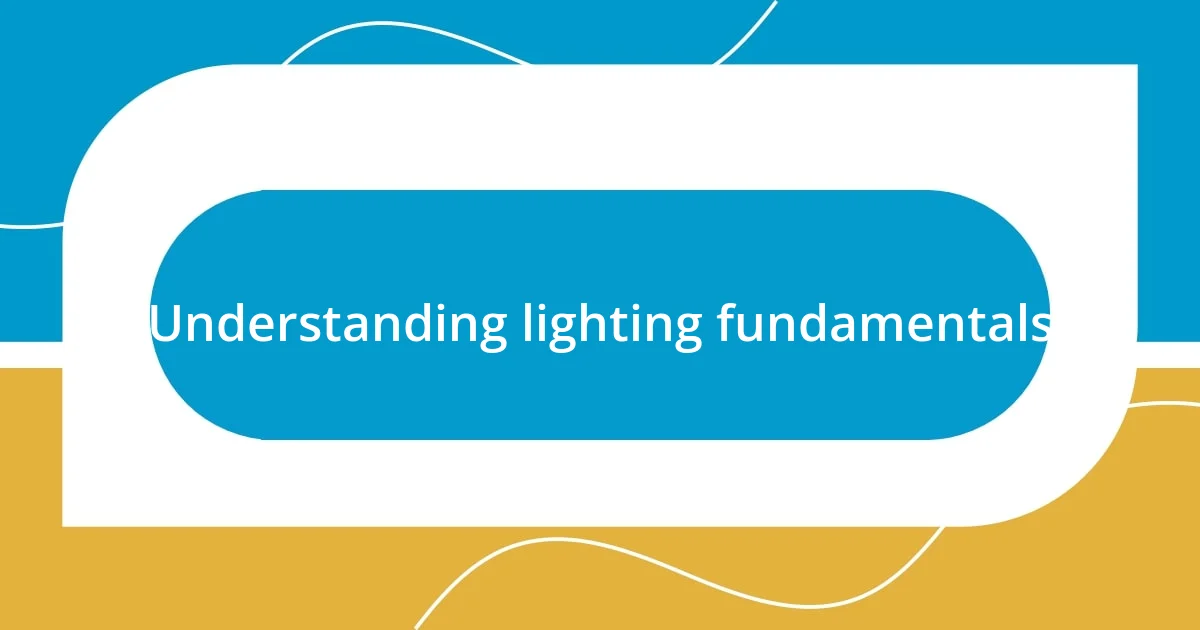
Understanding lighting fundamentals
Lighting is the backbone of any visual storytelling. I’ve often found myself in situations where I’ve curated a scene, only to realize that the right light can transform it entirely. Have you ever witnessed a sunset that made everything around it glow? That’s the magic of lighting in action, shaping our perceptions and emotions.
Understanding key concepts like color temperature and intensity is crucial. I remember my first project where I neglected white balance, resulting in murky tones that stripped the vibrancy from my shots. It’s an essential lesson: our choices in lighting can evoke specific feelings, from warmth and comfort to starkness and tension.
Additionally, consider how shadows play a role in storytelling. Shadows can add drama or create depth, often influencing how the viewer connects with the subject. I once captured a portrait of a friend with harsh side lighting, and it added a layer of intrigue that sparked conversations about vulnerability. Have you thought about how shadows might tell a story in your setups?
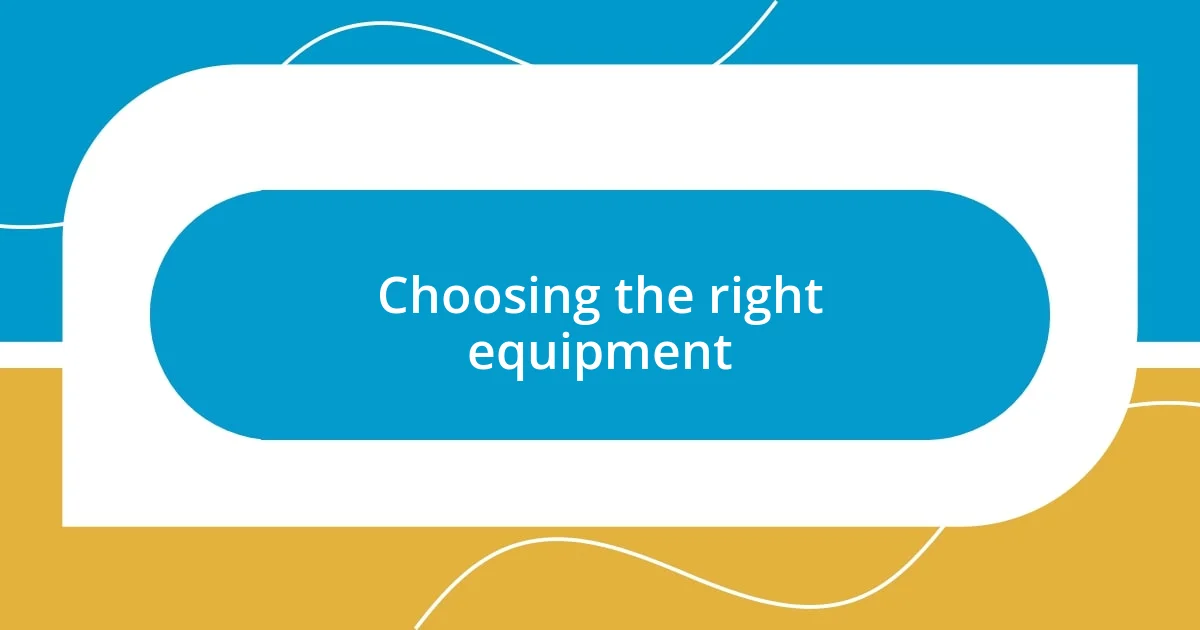
Choosing the right equipment
When it comes to choosing the right equipment, I always emphasize the importance of understanding your specific needs first. I learned this during a shoot where I hastily relied on whatever gear I had on hand, only to realize it didn’t match the vision I had in mind. The right equipment not only enhances your capabilities but also allows you to express your unique creative vision.
Here are some key factors to consider when selecting lighting equipment:
- Type of Light: Decide between continuous lighting or strobes based on your shooting style. I prefer continuous lights for video since they provide consistent illumination.
- Portability: If you often work on location, lightweight and compact gear can make a big difference. I learned the hard way when I struggled to carry heavy equipment during an outdoor shoot.
- Adjustability: Look for lights with adjustable intensity and color temperature. This flexibility has saved me countless times in post-production when I needed a specific mood.
- Modifiers: Don’t overlook softboxes or reflectors. They can work wonders in diffusing light and creating a soft feel, as I discovered while experimenting with different setups for a wedding shoot.
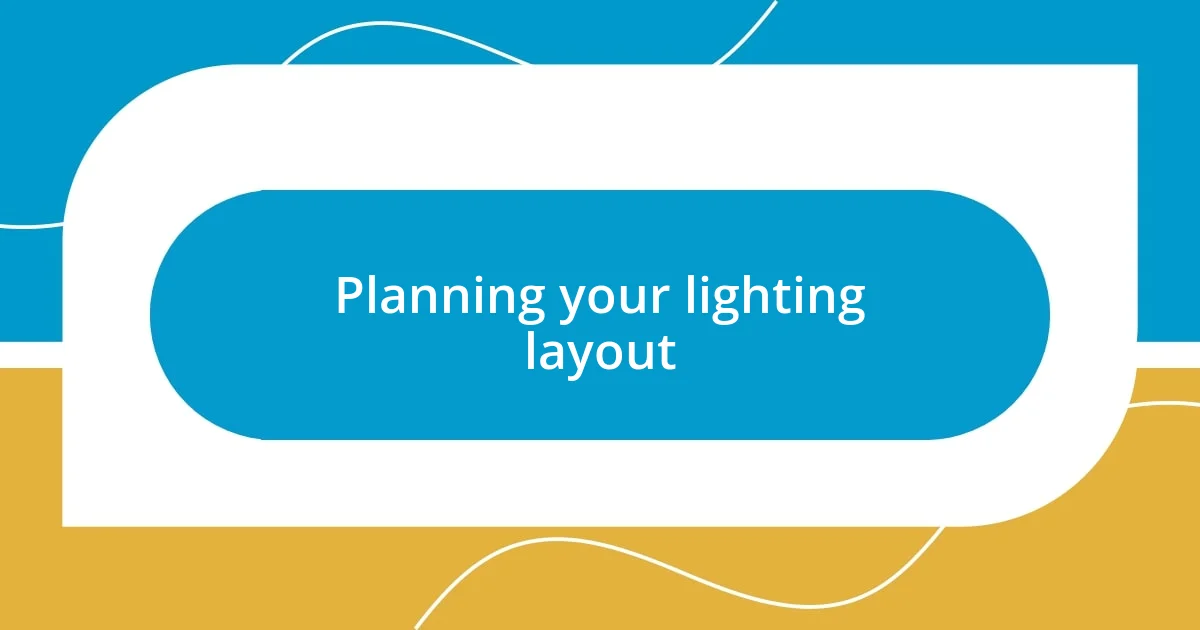
Planning your lighting layout
When I first started planning my lighting layouts, I underestimated the importance of a solid pre-visualization. Sketching out a rough diagram of the scene in advance helped me organize my thoughts and visualize how different light sources would interact. Have you ever tried laying things out on paper? It can be incredibly freeing, making complex setups feel accessible and manageable.
Alongside sketching, I’ve found that conducting a test run before the actual shoot can reveal unforeseen challenges. One memorable instance involved setting up multiple light sources for a product shoot, where I discovered that certain angles created unflattering shadows. Adjustments at this stage saved me a lot of time later. Planning allows for those tweaks that make a significant difference when the camera starts rolling.
Moreover, keeping track of the lighting positions and settings can save you from frustration during the actual shoot. I learned to take notes on everything from the height of my lights to the intensity used. Sharing this info with my team ensured we remained consistent across multiple takes. In essence, thoughtful planning elevates the entire process, transforming it from chaos to a structured art form.
| Aspect | Importance |
|---|---|
| Pre-visualization | Helps in organizing thoughts and visualizing the scene |
| Test runs | Reveals unforeseen challenges before the actual shoot |
| Documentation | Ensures consistency and saves time during the shoot |

Using software for lighting design
Using software for lighting design has been a game changer for me. When I first discovered lighting design software, it felt like I stepped into a whole new world where I could visualize my setups digitally before lifting a physical light. I recall a particular project where I used software to plan a complex theatrical production. Instead of second-guessing my decisions on the fly, I could simulate various lighting scenarios and see how they played out in real-time. It was exhilarating to watch my ideas come to life on screen!
Not all software is created equal, though. I’ve experimented with several programs, and I learned quickly that usability makes a significant difference. For instance, I found that user-friendly software not only sped up my workflow but also decreased the stress I felt during the pre-production stage. Have you ever felt overwhelmed by the sheer number of options when choosing a program? I know I have. My go-to solution became seeking programs that simplified the interface while offering robust features—like generating accurate light plots and color renditions.
Additionally, I’ve realized that incorporating software into my process helps me communicate my vision more effectively with collaborators. During one shoot with a talented but nervous crew, I used software to create a 3D model of our set along with the lighting plan. Sharing this model eased everyone’s anxieties and allowed us to collaborate efficiently. Seeing our collective vision reflected in that digital space truly solidified our teamwork, making it much easier to tackle the shoot. In that moment, the software did more than assist in lighting; it bridged the gap between ideas and execution.
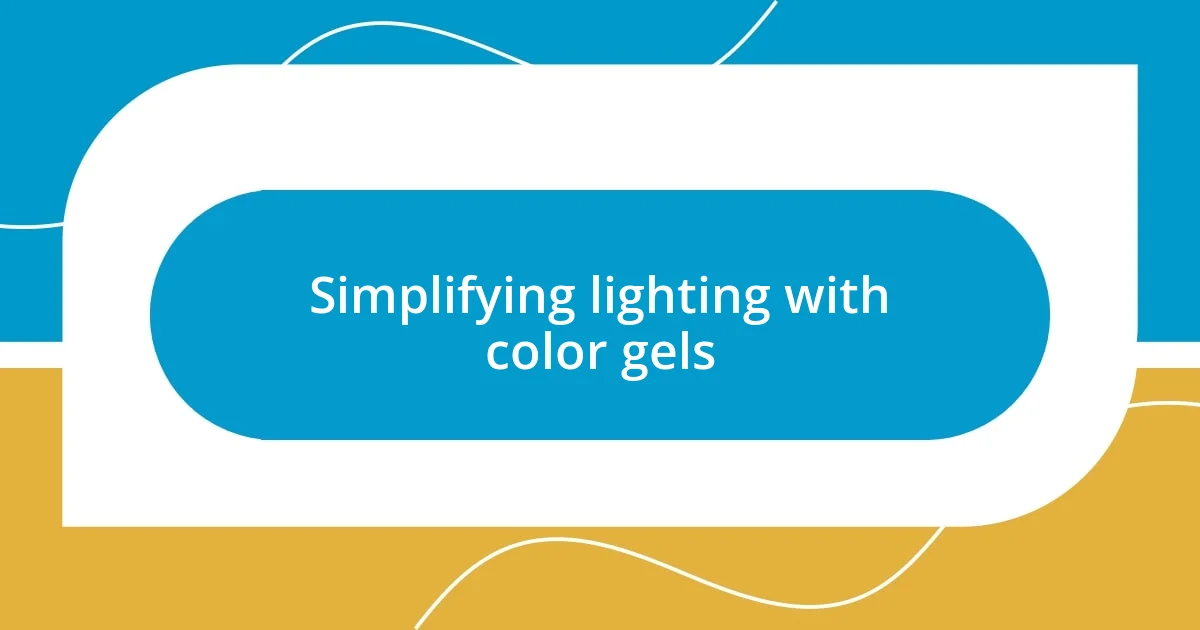
Simplifying lighting with color gels
Incorporating color gels into my lighting setups has drastically simplified my approach. I vividly remember a shoot where I used a vibrant red gel to transform an ordinary scene into something dramatic and captivating. Just by swapping out a standard light bulb for one fitted with a gel, I was able to evoke a completely different mood that required hardly any effort on my part. Isn’t it amazing how a splash of color can breathe new life into your work?
One of the best parts of using gels is testing them out to see how they interact with various light sources. I often find myself experimenting with different combinations during my pre-production phase. For instance, while prepping for a music video, I played around with a blue gel alongside a softbox. The result created a stunning contrast against the warm tones of the performer’s skin. These little experiments not only streamline my process but also open up opportunities for creative surprises that enrich the final product.
It’s incredibly empowering to realize that you don’t need expensive equipment to achieve professional effects. Just a few color gels can elevate a simple lighting setup into something dynamic and eye-catching. Have you ever faced a creative block during a shoot? I have, and those moments often led me to experiment more with gels, transforming my frustration into inspiration. Every time I introduce a new gel, I feel a rush of excitement, as if I’m unlocking a new possibility in my visual storytelling.
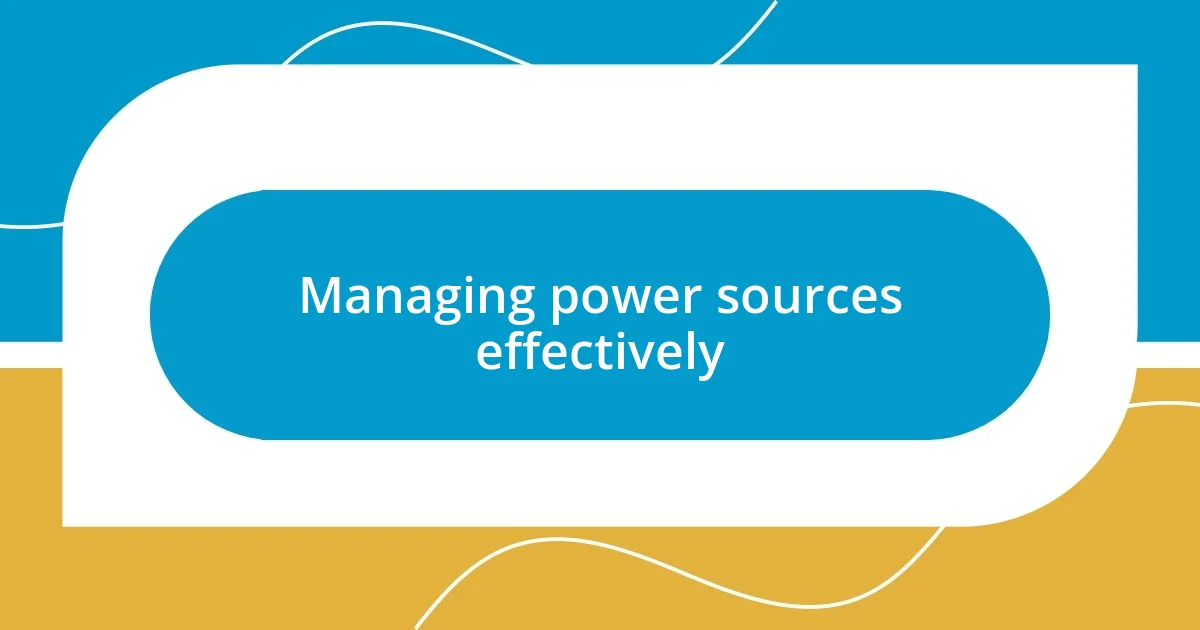
Managing power sources effectively
When it comes to managing power sources effectively, I’ve had my fair share of challenges and lessons learned. I remember prepping for a large outdoor event where overlapping power demands felt like a puzzle I had to solve. On that occasion, I quickly realized the importance of creating a power distribution plan. Having a clear layout meant I could prioritize my lighting fixtures, ensuring that the more power-hungry equipment wouldn’t trip the circuit. It’s that kind of preparation that saves you from a last-minute scramble, don’t you think?
Another key strategy I’ve adopted is using power strips and extension cords thoughtfully. During a recent music festival, I discovered that labeling cords allowed my team to plug in without confusion. Each section of the venue had designated power sources, and it made adjusting setups go smoother. I felt a wave of relief seeing everything organized—it’s like guiding a ship with a clear map instead of charting unknown waters!
Finally, I often consider having backup power solutions on standby. In one memorable shoot, a sudden storm threatened to disrupt our plans. Thankfully, I had brought along battery packs that kept our essential lights running. That moment demonstrated the importance of flexibility in power management. A little foresight can turn a potential disaster into a seamless production experience. Have you ever faced a similar situation, where a backup plan saved the day? I know I have, and it only reinforced my commitment to always have contingencies in place.
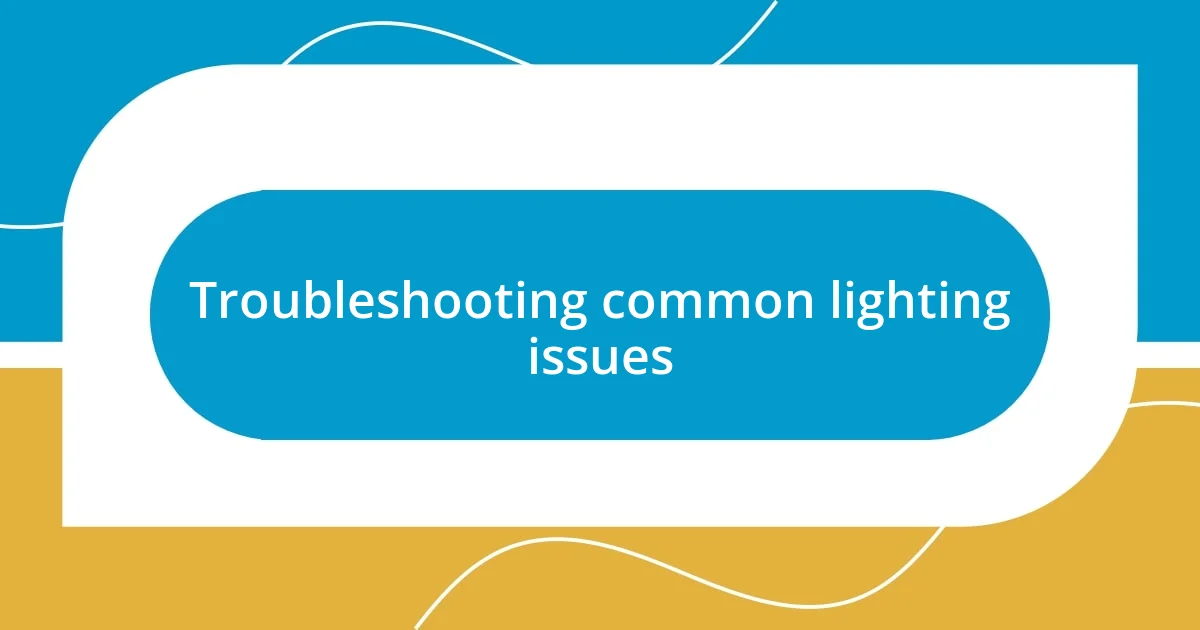
Troubleshooting common lighting issues
Lighting can sometimes throw unexpected challenges your way. I recall a shoot where shadows seemed to dance around my subjects, completely ruining the intended vibe. I swiftly adjusted by angling the lights and introducing fill lights to soften those harsh shadows. It was like watching a scene come to life again. Have you ever experienced a moment like that? It’s incredible what a simple repositioning can achieve!
Another common issue I’ve encountered is unexpected color temperature mismatches. One time, I set up a mix of LED and tungsten lights only to realize the color cast was off, leaving my subjects looking too cool. In the heat of the moment, I switched to daylight-balanced gels to unify the lighting. The difference was astonishing! I’ve learned that keeping a dedicated set of gels handy can save you from those frustrating instances where your vision gets distorted by the wrong color temperature.
Sometimes, the simplest fixes can become the most delightful surprises. During a recent shoot, one of my lights started flickering, which could have derailed the whole project. Instead of panicking, I grabbed a spare bulb, swapped it in, and found that it produced a softer, more appealing glow. It’s moments like this that remind me how agility and quick thinking in troubleshooting can turn a hiccup into an opportunity. So, have you considered how a backup solution can elevate your lighting game? I find it essential—it’s all part of the creative journey!














